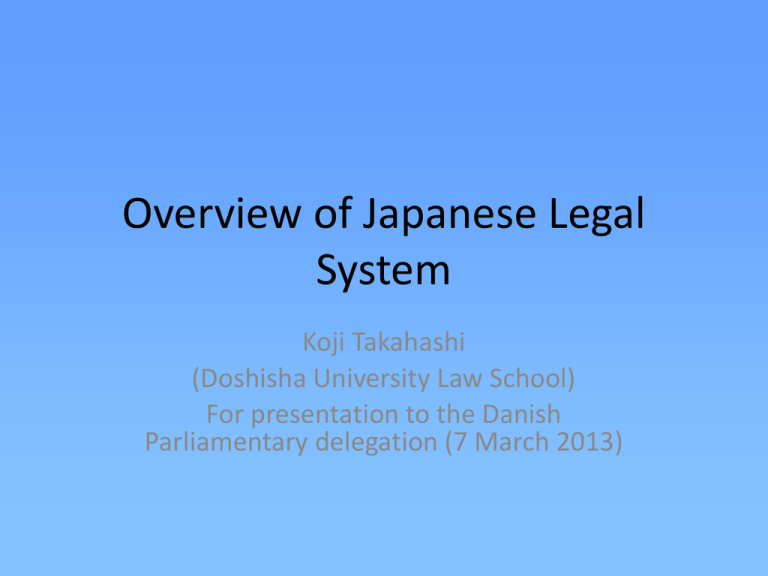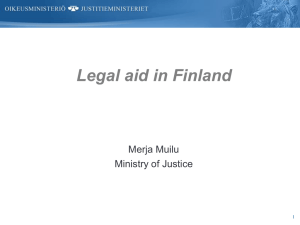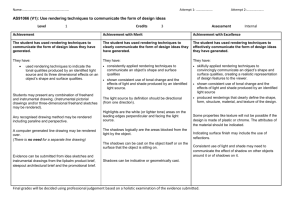Overview of Japanese Legal System
advertisement

Overview of Japanese Legal System Koji Takahashi (Doshisha University Law School) For presentation to the Danish Parliamentary delegation (7 March 2013) Importation of foreign law • Edo era: over 200 years of national isolation. • Meiji era (1868-1911) – Introduction of the Western civilization. – In law, primarily German, but some French, influence. • e.g. Civil Code, Code of Civil procedure, Commercial Code • After World War II – American influence • e.g. Constitution, anti-monopoly law Low-key role of law (~80s) • Weak “legal consciousness” – “sosho-zata”: (pejoratively) going to court. – “Should a dispute arise between the parties with regard to this contract, the parties shall settle it by consultation.” – Kubo v. Tamura (Tsu District Court judgment 21 April 1983) • Corporate business scene: controlled by bureaucrats. – Best and brightest of graduates would seek employment in central government. – “Amakudari” = descent from the heaven = Retired bureaucrats parachuting onto private-sector companies. – “Japan Inc.”: government-led revival (esp. 50s ~70s). Methods of implementing administrative policies • Administrative dispositions (formal method under statutes or ordinances) e.g. orders, permits, revocation of permits, rejection of applications. – Reviewable by court. • Administrative guidance (informal, non-binding method) e.g. recommendation, suggestion, encouragement, advice, warning. – Non-reviewable by court except where any sanction for disobedience is imposed which constitutes a tortious act on the part of the bureaucrat. – Supported by implied threats of actions or inactions (e.g. withholding permits): Outlawed by 1993 Act. – e.g. Sumitomo Metal incident (1964) Legal services market until mid-90s • Companies would turn to bureaucrats for advice on permissibility of products and transactions. • Companies would not rely on attorneys to conduct domestic business. • Transactional legal work was concentrated on the international side of business, an area of practice of a small minority of attorneys. • The work of a great majority of attorneys was centered on litigation. Administrative Procedures Act (1993) • Formalized regulatory process for administrative dispositions and administrative guidance. • Article 32(1) Persons rendering administrative guidance shall make sure that … the aim of the guidance is, to the utmost degree, to be achieved solely on the basis of the voluntary cooperation of the subject parties. • (2) Persons rendering administrative guidance shall not treat the subject parties disadvantageously because of their non-compliance with the guidance. Administrative Procedures Act (1993) • Article 35(1) Persons rendering administrative guidance shall make clear to the subject party the purpose and content of, and the persons responsible for, the guidance. • (2) Where administrative guidance is rendered orally, the person rendering it shall, if so requested by the subject party, provide the matters referred to in the preceding paragraph in writing, so long as no extraordinary administrative inconvenience arises therefrom. Shift to rule-based and transparent business climate (from mid-90s) • Shift from ex-ante executive regulations to ex-post judicial remedies. • Demand for legal services on domestic transactions and corporate affairs has increased. – Shareholders activism in derivative actions. – e.g. Sumitomo v. UFJ (2004): a prolonged two-year legal battle among three of Japan's "Big Four" banking groups. • Emergence of large corporate law firms. – Used to be called “shogai” (international) law firms. – Now, more work on domestic than international business. – To meet the increased demand for speed and diversity. • Other firms, too, have grown in size. Number of Shareholder’s derivative actions (at first-instance courts) (from http://www.irric.co.jp/risk_info/csr/pdf/csrtopics2012_05.pdf) From the website of the Supreme Court of Japan (http://www.courts.go.jp/english/proceedings/civil_suit_index/index.html) Modernization of statutes – Code of Civil Procedure (1996, 2011) – Arbitration Law (2003) – Bankruptcy Act (2004) – Companies Act (2005) – Act on the Application of Laws (2006) – Civil Code (2015?) • Continued attention to foreign legal systems. • But based more on decades of Japan’s own experience. Rule of law yet to take roots? • Deference and submissiveness to authorities remain strong. • Demands in some quarters of legal market remain unfilled. – Highly specialized fields. – Rural areas. – Attorney’s monopoly over all legal services (including provision of legal advice) (Attorney Act, Art. 72) Size of population served by one attorney (from Bengoshi Hakusho 2012)











